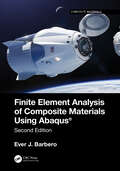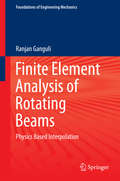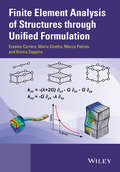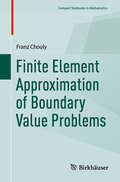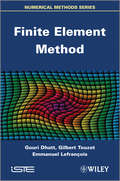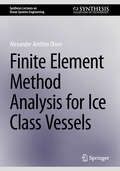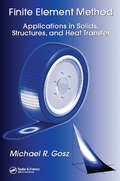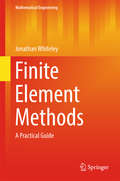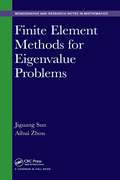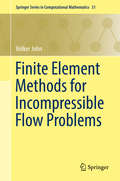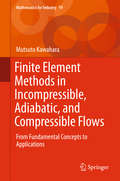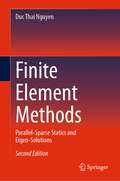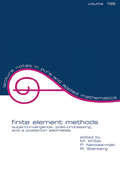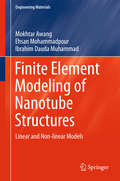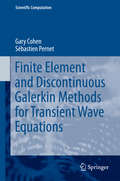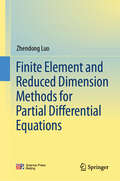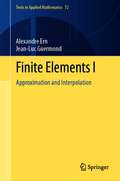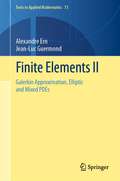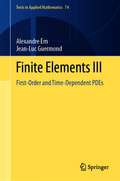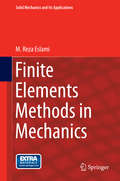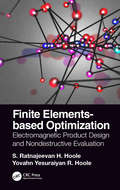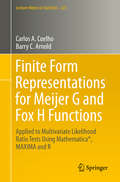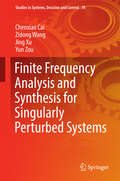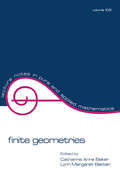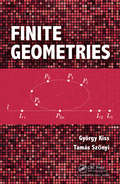- Table View
- List View
Finite Element Analysis of Composite Materials using Abaqus® (Composite Materials)
by Ever J. BarberoDeveloped from the author’s course on advanced mechanics of composite materials, Finite Element Analysis of Composite Materials with Abaqus® shows how powerful finite element tools tackle practical problems in the structural analysis of composites. This Second Edition includes two new chapters on "Fatigue" and "Abaqus Programmable Features" as well as a major update of chapter 10 "Delaminations" and significant updates throughout the remaining chapters. Furthermore, it updates all examples, sample code, and problems to Abaqus 2020. Unlike other texts, this one takes theory to a hands-on level by actually solving problems. It explains the concepts involved in the detailed analysis of composites, the mechanics needed to translate those concepts into a mathematical representation of the physical reality, and the solution of the resulting boundary value problems using Abaqus. The reader can follow a process to recreate every example using Abaqus graphical user interface (CAE) by following step-by-step directions in the form of pseudo-code or watching the solutions on YouTube. The first seven chapters provide material ideal for a one-semester course. Along with offering an introduction to finite element analysis for readers without prior knowledge of the finite element method, these chapters cover the elasticity and strength of laminates, buckling analysis, free edge stresses, computational micromechanics, and viscoelastic models for composites. Emphasizing hereditary phenomena, the book goes on to discuss continuum and discrete damage mechanics as well as delaminations and fatigue. The text also shows readers how to extend the capabilities of Abaqus via "user subroutines" and Python scripting. Aimed at advanced students and professional engineers, this textbook features 62 fully developed examples interspersed with the theory, 82 end-of-chapter exercises, and 50+ separate pieces of Abaqus pseudo-code that illustrate the solution of example problems. The author’s website offers the relevant Abaqus and MATLAB model files available for download, enabling readers to easily reproduce the examples and complete the exercises. Video recording of solutions to examples are available on YouTube with multilingual captions.
Finite Element Analysis of Rotating Beams
by Ranjan GanguliThis book addresses the solution of rotating beam free-vibration problems using the finite element method. It provides an introduction to the governing equation of a rotating beam, before outlining the solution procedures using Rayleigh-Ritz, Galerkin and finite element methods. The possibility of improving the convergence of finite element methods through a judicious selection of interpolation functions, which are closer to the problem physics, is also addressed. The book offers a valuable guide for students and researchers working on rotating beam problems - important engineering structures used in helicopter rotors, wind turbines, gas turbines, steam turbines and propellers - and their applications. It can also be used as a textbook for specialized graduate and professional courses on advanced applications of finite element analysis.
Finite Element Analysis of Structures through Unified Formulation
by Erasmo Carrera Marco Petrolo Enrico Zappino Maria CinefraThe finite element method (FEM) is a computational tool widely used to design and analyse complex structures. Currently, there are a number of different approaches to analysis using the FEM that vary according to the type of structure being analysed: beams and plates may use 1D or 2D approaches, shells and solids 2D or 3D approaches, and methods that work for one structure are typically not optimized to work for another. Finite Element Analysis of Structures Through Unified Formulation deals with the FEM used for the analysis of the mechanics of structures in the case of linear elasticity. The novelty of this book is that the finite elements (FEs) are formulated on the basis of a class of theories of structures known as the Carrera Unified Formulation (CUF). It formulates 1D, 2D and 3D FEs on the basis of the same 'fundamental nucleus' that comes from geometrical relations and Hooke's law, and presents both 1D and 2D refined FEs that only have displacement variables as in 3D elements. It also covers 1D and 2D FEs that make use of 'real' physical surfaces rather than 'artificial' mathematical surfaces which are difficult to interface in CAD/CAE software. Key features: Covers how the refined formulation can be easily and conveniently used to analyse laminated structures, such as sandwich and composite structures, and to deal with multifield problems Shows the performance of different FE models through the 'best theory diagram' which allows different models to be compared in terms of accuracy and computational cost Introduces an axiomatic/asymptotic approach that reduces the computational cost of the structural analysis without affecting the accuracy Introduces an innovative 'component-wise' approach to deal with complex structures Accompanied by a website hosting the dedicated software package MUL2 (www.mul2.com) Finite Element Analysis of Structures Through Unified Formulation is a valuable reference for researchers and practitioners, and is also a useful source of information for graduate students in civil, mechanical and aerospace engineering.
Finite Element Approximation of Boundary Value Problems (Compact Textbooks in Mathematics)
by Franz ChoulyThis textbook provides an accessible introduction to the mathematical foundations of the finite element method for a broad audience. The author accomplishes this, in part, by including numerous exercises and illustrations. Each chapter begins with a clear outline to help make complex concepts more approachable without sacrificing depth. Structurally, the book begins with the simplest type of finite element method: low order, piecewise continuous, Lagrange finite elements. With this, crucial questions about the stability and approximation errors are answered. Of particular note is the author’s coverage of two specific topics that often go overlooked in introductory material. The first is the numerical treatment of boundary conditions, especially the Nitsche technique. The second is a detailed explanation of the discretization error using specific techniques of a posteriori error estimation. With the book’s compact yet thorough treatment of these areas, readers will have a clear understanding of how mathematical analysis tools can be used in practice. Finite Element Approximation of Boundary Value Problems will be suitable as a supplementary textbook in applied mathematics courses for graduate students, and may also be used for self-study.
Finite Element Method (Wiley-iste Ser.)
by Gilbert Touzot Emmanuel Lefrançois Gouri DhattThis book offers an in-depth presentation of the finite element method, aimed at engineers, students and researchers in applied sciences.The description of the method is presented in such a way as to be usable in any domain of application. The level of mathematical expertise required is limited to differential and matrix calculus.The various stages necessary for the implementation of the method are clearly identified, with a chapter given over to each one: approximation, construction of the integral forms, matrix organization, solution of the algebraic systems and architecture of programs. The final chapter lays the foundations for a general program, written in Matlab, which can be used to solve problems that are linear or otherwise, stationary or transient, presented in relation to applications stemming from the domains of structural mechanics, fluid mechanics and heat transfer.
Finite Element Method Analysis for Ice Class Vessels (Synthesis Lectures on Ocean Systems Engineering)
by Alexander Arnfinn OlsenThis book provides ship designers with clear guidance on alternative design procedures for hull side structures, power requirements, and propeller strength assessment based on the Finite Element Method for Baltic Ice Class Vessels. Through this comprehensive guide, readers will learn the intricacies of designing vessels capable of navigating the harsh ice conditions of the Baltic Sea. The chapters cover topics such as ice strengthening designs using direct calculation approaches, power requirement calculations for ice class vessels, and strength analysis of propellers. The authors present an expert analysis of these critical aspects, offering practical solutions and methodologies that are essential for marine engineers and naval architects. This book is a must-read for anyone involved in the design and construction of ice-class vessels, providing invaluable insights into the latest research and best practices in the field. This guide is indispensable for naval architects, marine engineering students, marine surveyors, and professionals working in maritime defense and shipping registries. It serves as a reference for academics and students in marine design and engineering, as well as a textbook for marine engineering courses. With contributions from experienced practitioners in the field, this book offers both theoretical perspectives and practical case studies that will benefit anyone involved in the design and operation of ice-class vessels.
Finite Element Method: Applications in Solids, Structures, and Heat Transfer (Mechanical Engineering)
by Michael R. GoszThe finite element method (FEM) is the dominant tool for numerical analysis in engineering, yet many engineers apply it without fully understanding all the principles. Learning the method can be challenging, but Mike Gosz has condensed the basic mathematics, concepts, and applications into a simple and easy-to-understand reference.Finite Element Method: Applications in Solids, Structures, and Heat Transfer navigates through linear, linear dynamic, and nonlinear finite elements with an emphasis on building confidence and familiarity with the method, not just the procedures. This book demystifies the assumptions made, the boundary conditions chosen, and whether or not proper failure criteria are used. It reviews the basic math underlying FEM, including matrix algebra, the Taylor series expansion and divergence theorem, vectors, tensors, and mechanics of continuous media.The author discusses applications to problems in solid mechanics, the steady-state heat equation, continuum and structural finite elements, linear transient analysis, small-strain plasticity, and geometrically nonlinear problems. He illustrates the material with 10 case studies, which define the problem, consider appropriate solution strategies, and warn against common pitfalls. Additionally, 35 interactive virtual reality modeling language files are available for download from the CRC Web site.For anyone first studying FEM or for those who simply wish to deepen their understanding, Finite Element Method: Applications in Solids, Structures, and Heat Transfer is the perfect resource.
Finite Element Methods
by Jonathan WhiteleyThis book presents practical applications of the finite element method to general differential equations. The underlying strategy of deriving the finite element solution is introduced using linear ordinary differential equations, thus allowing the basic concepts of the finite element solution to be introduced without being obscured by the additional mathematical detail required when applying this technique to partial differential equations. The author generalizes the presented approach to partial differential equations which include nonlinearities. The book also includes variations of the finite element method such as different classes of meshes and basic functions. Practical application of the theory is emphasised, with development of all concepts leading ultimately to a description of their computational implementation illustrated using Matlab functions. The target audience primarily comprises applied researchers and practitioners in engineering, but the book may also be beneficial for graduate students.
Finite Element Methods for Eigenvalue Problems (Chapman & Hall/CRC Monographs and Research Notes in Mathematics)
by Jiguang Sun Aihui ZhouThis book covers finite element methods for several typical eigenvalues that arise from science and engineering. Both theory and implementation are covered in depth at the graduate level. The background for typical eigenvalue problems is included along with functional analysis tools, finite element discretization methods, convergence analysis, techniques for matrix evaluation problems, and computer implementation. The book also presents new methods, such as the discontinuous Galerkin method, and new problems, such as the transmission eigenvalue problem.
Finite Element Methods for Incompressible Flow Problems
by Volker JohnThis book explores finite element methods for incompressible flow problems: Stokes equations, stationary Navier-Stokes equations and time-dependent Navier-Stokes equations. It focuses on numerical analysis, but also discusses the practical use of these methods and includes numerical illustrations. It also provides a comprehensive overview of analytical results for turbulence models. The proofs are presented step by step, allowing readers to more easily understand the analytical techniques.
Finite Element Methods in Incompressible, Adiabatic, and Compressible Flows
by Mutsuto KawaharaThis book focuses on the finite element method influid flows. It is targeted at researchers, from those just starting out up topractitioners with some experience. Part I is devoted to the beginners who arealready familiar with elementary calculus. Precise concepts of the finiteelement method remitted in the field of analysis of fluid flow are stated,starting with spring structures, which are most suitable to show the conceptsof superposition/assembling. Pipeline system and potential flow sections showthe linear problem. The advection-diffusion section presents the time-dependentproblem; mixed interpolation is explained using creeping flows, and elementarycomputer programs by FORTRAN are included. Part II provides information on recentcomputational methods and their applications to practical problems. Theories ofStreamline-Upwind/Petrov-Galerkin (SUPG) formulation, characteristicformulation, and Arbitrary Lagrangian-Eulerian (ALE) formulation and others arepresented with practical results solved by those methods.
Finite Element Methods: Parallel-Sparse Statics and Eigen-Solutions
by Duc Thai NguyenThis new edition includes three new chapters, 7 through 9, that have very broad, practical applications in engineering and science. In addition, the author’s latest research results incorporated into the new textbook demonstrates better performance than the popular METIS software for partitioning graphs, partitioning finite element meshes, and producing fill-reducing orderings for sparse matrices. The new Chapter 8, and its pre-requisite, Chapter 7, present a state-of-the-art algorithm for computing the shortest paths for real-life (large-scale) transportation networks with minimum computational time. This approach has not yet appeared in any existing textbooks and it could open the doors for other transportation engineering applications. Chapter 9 vastly expands the scope of the previous edition by including sensitivity (gradient) computation and MATLAB’s built-in function “fmincon” for obtaining the optimum (or best) solution for general engineering problems.
Finite Element Methods: Superconvergence, Post-Processing, and A Posterior Estimates (Lecture Notes In Pure And Applied Mathematics Ser.)
by P. Neittaanmäki M. Křížek R. Stenberg""Based on the proceedings of the first conference on superconvergence held recently at the University of Jyvaskyla, Finland. Presents reviewed papers focusing on superconvergence phenomena in the finite element method. Surveys for the first time all known superconvergence techniques, including their proofs.
Finite Element Modeling of Nanotube Structures
by Mokhtar Awang Ehsan Mohammadpour Ibrahim Dauda MuhammadThis book presents a new approach to modeling carbon structures such as graphene and carbon nanotubes using finite element methods, and addresses the latest advances in numerical studies for these materials. Based on the available findings, the book develops an effective finite element approach for modeling the structure and the deformation of grapheme-based materials. Further, modeling processing for single-walled and multi-walled carbon nanotubes is demonstrated in detail.
Finite Element and Discontinuous Galerkin Methods for Transient Wave Equations
by Gary Cohen Sébastien PernetThis monograph presents numerical methods for solving transient wave equations (i. e. in time domain). More precisely, it provides an overview of continuous and discontinuous finite element methods for these equations, including their implementation in physical models, an extensive description of 2D and 3D elements with different shapes, such as prisms or pyramids, an analysis of the accuracy of the methods and the study of the Maxwell's system and the important problem of its spurious free approximations. After recalling the classical models, i. e. acoustics, linear elastodynamics and electromagnetism and their variational formulations, the authors present a wide variety of finite elements of different shapes useful for the numerical resolution of wave equations. Then, they focus on the construction of efficient continuous and discontinuous Galerkin methods and study their accuracy by plane wave techniques and a priori error estimates. A chapter is devoted to the Maxwell's system and the important problem of its spurious-free approximations. Treatment of unbounded domains by Absorbing Boundary Conditions (ABC) and Perfectly Matched Layers (PML) is described and analyzed in a separate chapter. The two last chapters deal with time approximation including local time-stepping and with the study of some complex models, i. e. acoustics in flow, gravity waves and vibrating thin plates. Throughout, emphasis is put on the accuracy and computational efficiency of the methods, with attention brought to their practical aspects. This monograph also covers in details the theoretical foundations and numerical analysis of these methods. As a result, this monograph will be of interest to practitioners, researchers, engineers and graduate students involved in the numerical simulation of waves.
Finite Element and Reduced Dimension Methods for Partial Differential Equations
by Zhendong LuoThis book aims to provide with some approaches for lessening the unknowns of the FE methods of unsteady PDEs. It provides a very detailed theoretical foundation of finite element (FE) and mixed finite element (MFE) methods in the first 2 chapters, and then Chapter 3 provides the FE and MFE methods to solve unsteady partial differential equations (PDEs). In the following 2 chapters, the principle and application of two proper orthogonal decomposition (POD) methods are introduced in detail. This book can be used as both the introduction of FE method and the gateway to the FE frontier. For readers who want to learn the FE and MFE methods for solving various steady and unsteady PDEs, they will find the first 3 chapters very helpful. While those who care about engineering applications may jump to the last 2 chapters that introduce the construction of dimension reduction models and their applications to practical process calculations. This part could help them to improve the calculation efficiency and save CPU runtime so as to do wonders for their engineering calculations.
Finite Elements I: Approximation and Interpolation (Texts in Applied Mathematics #72)
by Alexandre Ern Jean-Luc GuermondThis book is the first volume of a three-part textbook suitable for graduate coursework, professional engineering and academic research. It is also appropriate for graduate flipped classes. Each volume is divided into short chapters. Each chapter can be covered in one teaching unit and includes exercises as well as solutions available from a dedicated website. The salient ideas can be addressed during lecture, with the rest of the content assigned as reading material. To engage the reader, the text combines examples, basic ideas, rigorous proofs, and pointers to the literature to enhance scientific literacy. Volume I is divided into 23 chapters plus two appendices on Banach and Hilbert spaces and on differential calculus. This volume focuses on the fundamental ideas regarding the construction of finite elements and their approximation properties. It addresses the all-purpose Lagrange finite elements, but also vector-valued finite elements that are crucial to approximate the divergence and the curl operators. In addition, it also presents and analyzes quasi-interpolation operators and local commuting projections. The volume starts with four chapters on functional analysis, which are packed with examples and counterexamples to familiarize the reader with the basic facts on Lebesgue integration and weak derivatives. Volume I also reviews important implementation aspects when either developing or using a finite element toolbox, including the orientation of meshes and the enumeration of the degrees of freedom.
Finite Elements II: Galerkin Approximation, Elliptic and Mixed PDEs (Texts in Applied Mathematics #73)
by Alexandre Ern Jean-Luc GuermondThis book is the second volume of a three-part textbook suitable for graduate coursework, professional engineering and academic research. It is also appropriate for graduate flipped classes. Each volume is divided into short chapters. Each chapter can be covered in one teaching unit and includes exercises as well as solutions available from a dedicated website. The salient ideas can be addressed during lecture, with the rest of the content assigned as reading material. To engage the reader, the text combines examples, basic ideas, rigorous proofs, and pointers to the literature to enhance scientific literacy.Volume II is divided into 32 chapters plus one appendix. The first part of the volume focuses on the approximation of elliptic and mixed PDEs, beginning with fundamental results on well-posed weak formulations and their approximation by the Galerkin method. The material covered includes key results such as the BNB theorem based on inf-sup conditions, Céa's and Strang's lemmas, and the duality argument by Aubin and Nitsche. Important implementation aspects regarding quadratures, linear algebra, and assembling are also covered. The remainder of Volume II focuses on PDEs where a coercivity property is available. It investigates conforming and nonconforming approximation techniques (Galerkin, boundary penalty, Crouzeix—Raviart, discontinuous Galerkin, hybrid high-order methods). These techniques are applied to elliptic PDEs (diffusion, elasticity, the Helmholtz problem, Maxwell's equations), eigenvalue problems for elliptic PDEs, and PDEs in mixed form (Darcy and Stokes flows). Finally, the appendix addresses fundamental results on the surjectivity, bijectivity, and coercivity of linear operators in Banach spaces.
Finite Elements III: First-Order and Time-Dependent PDEs (Texts in Applied Mathematics #74)
by Alexandre Ern Jean-Luc GuermondThis book is the third volume of a three-part textbook suitable for graduate coursework, professional engineering and academic research. It is also appropriate for graduate flipped classes. Each volume is divided into short chapters. Each chapter can be covered in one teaching unit and includes exercises as well as solutions available from a dedicated website. The salient ideas can be addressed during lecture, with the rest of the content assigned as reading material. To engage the reader, the text combines examples, basic ideas, rigorous proofs, and pointers to the literature to enhance scientific literacy. Volume III is divided into 28 chapters. The first eight chapters focus on the symmetric positive systems of first-order PDEs called Friedrichs' systems. This part of the book presents a comprehensive and unified treatment of various stabilization techniques from the existing literature. It discusses applications to advection and advection-diffusion equations and various PDEs written in mixed form such as Darcy and Stokes flows and Maxwell's equations. The remainder of Volume III addresses time-dependent problems: parabolic equations (such as the heat equation), evolution equations without coercivity (Stokes flows, Friedrichs' systems), and nonlinear hyperbolic equations (scalar conservation equations, hyperbolic systems). It offers a fresh perspective on the analysis of well-known time-stepping methods. The last five chapters discuss the approximation of hyperbolic equations with finite elements. Here again a new perspective is proposed. These chapters should convince the reader that finite elements offer a good alternative to finite volumes to solve nonlinear conservation equations.
Finite Elements Methods in Mechanics
by M. Reza EslamiThis book covers all basic areas of mechanical engineering, such as fluid mechanics, heat conduction, beams and elasticity with detailed derivations for the mass, stiffness and force matrices. It is especially designed to give physical feeling to the reader for finite element approximation by the introduction of finite elements to the elevation of elastic membrane. A detailed treatment of computer methods with numerical examples are provided. In the fluid mechanics chapter, the conventional and vorticity transport formulations for viscous incompressible fluid flow with discussion on the method of solution are presented. The variational and Galerkin formulations of the heat conduction, beams and elasticity problems are also discussed in detail. Three computer codes are provided to solve the elastic membrane problem. One of them solves the Poisson's equation. The second computer program handles the two dimensional elasticity problems and the third one presents the three dimensional transient heat conduction problems. The programs are written in C++ environment.
Finite Elements-based Optimization: Electromagnetic Product Design and Nondestructive Evaluation
by S. Hoole Yovahn HooleThis book is intended to be a cookbook for students and researchers to understand the finite element method and optimization methods and couple them to effect shape optimization. The optimization part of the book will survey optimization methods and focus on the genetic algorithm and Powell’s method for implementation in the codes. It will contain pseudo-code for the relevant algorithms and homework problems to reinforce the theory to compile finite element programs capable of shape optimization. Features Enables readers to understand the finite element method and optimization methods and couple them to effect shape optimization Presents simple approach with algorithms for synthesis Focuses on automated computer aided design (CAD) of electromagnetic devices Provides a unitary framework involving optimization and numerical modelling Discusses how to integrate open-source mesh generators into your code Indicates how parallelization of algorithms, especially matrix solution and optimization, may be approached cheaply using the graphics processing unit (GPU) that is available on most PCs today Includes coupled problem optimization using hyperthermia as an example
Finite Form Representations for Meijer G and Fox H Functions: Applied to Multivariate Likelihood Ratio Tests Using Mathematica®, MAXIMA and R (Lecture Notes in Statistics #223)
by Barry C. Arnold Carlos A. CoelhoThis book depicts a wide range of situations in which there exist finite form representations for the Meijer G and the Fox H functions. Accordingly, it will be of interest to researchers and graduate students who, when implementing likelihood ratio tests in multivariate analysis, would like to know if there exists an explicit manageable finite form for the distribution of the test statistics. In these cases, both the exact quantiles and the exact p-values of the likelihood ratio tests can be computed quickly and efficiently.The test statistics in question range from common ones, such as those used to test e.g. the equality of means or the independence of blocks of variables in real or complex normally distributed random vectors; to far more elaborate tests on the structure of covariance matrices and equality of mean vectors. The book also provides computational modules in Mathematica®, MAXIMA and R, which allow readers to easily implement, plot and compute the distributions of any of these statistics, or any other statistics that fit into the general paradigm described here.
Finite Frequency Analysis and Synthesis for Singularly Perturbed Systems
by Zidong Wang Chenxiao Cai Jing Xu Yun ZouThis book is a self-contained collection of recent research findings providing a comprehensive and systematic unified framework for both analysis and synthesis for singularly perturbed systems. It paves the way for the gap between frequency-domain-transfer-function-based results and time-domain-state-space-based results to be bridged. It is divided into three parts focusing on: fundamental background of singular perturbation; general singular perturbation methodologies and time-scale techniques and the theoretical foundation of finite-frequency control; the analysis and synthesis of singularly perturbed systems; and real-world engineering applications implementing the results developed in systems like wind turbines and autonomous-aerial-vehicle hovering. It also presents solutions to analysis and design problems in terms of linear matrix inequalities. Lastly, it provides valuable reference material for researchers who wish to explore the design of controllers for such systems.
Finite Geometries
by Catherine Anne BakerThis book is a compilation of the papers presented at the conference in Winnipeg on the subject of finite geometry in 1984. It covers different fields in finite geometry: classical finite geometry, the geometry of finite planes, geometric structures and the theory of translation planes.
Finite Geometries
by Gyorgy Kiss Tamas SzonyiFinite Geometries stands out from recent textbooks about the subject of finite geometries by having a broader scope. The authors thoroughly explain how the subject of finite geometries is a central part of discrete mathematics. The text is suitable for undergraduate and graduate courses. Additionally, it can be used as reference material on recent works. The authors examine how finite geometries’ applicable nature led to solutions of open problems in different fields, such as design theory, cryptography and extremal combinatorics. Other areas covered include proof techniques using polynomials in case of Desarguesian planes, and applications in extremal combinatorics, plus, recent material and developments. Features: Includes exercise sets for possible use in a graduate course Discusses applications to graph theory and extremal combinatorics Covers coding theory and cryptography Translated and revised text from the Hungarian published version
